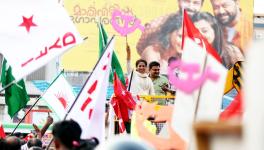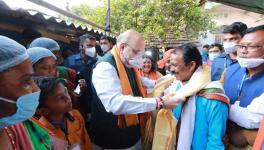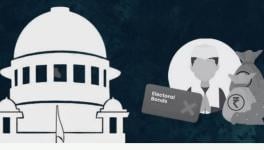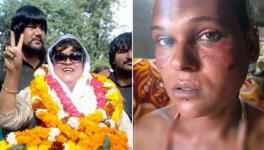Long Road Ahead for BJP, Like-Minded Partners in Kashmir
After the abrogation of Article 370 and the subsequent reconstitution of the state of Jammu and Kashmir (J&K) into the Union Territories of J&K and Ladakh, the mainstream political parties in the region are still trying to come to terms with reality.
The tsunami of constitutional changes post-August 5, 2019, brought what political analysts call “footprints without feet”. Mainstream politics had left its footprints everywhere in the form of demand for autonomy and self-rule, and healing touch—but its feet were only to be found chained inside guesthouses and state-owned buildings, fortified and designated as veritable prisons.
The once-upon ‘larger than life’ images of mainstream politicians were reduced to mere ‘numbers’ of political detainees with their detention orders categorically referring to them as “potential threat(s)” to peace and tranquility of the erstwhile state. At the same time, the Centre completely ignored their faith and allegiance to the Constitution, democracy and mainstream politics when the old J&K was grappling with a political vacuum and during the peak of insurgency in the early 90s.
On the other hand, the cessation of mainstream political activity in J&K invited severe criticism from relevant quarters that unanimously called for an end to such “measures”. The resultant last-minute firefighting measures by New Delhi to repose the global faith in Indian democracy were in the form of consecutive visits by European Union parliamentarians to J&K, more appropriately to Srinagar—the heart of the Bharatiya Janata Party’s “Naya Kashmir” politics.
While the Centre completely refuted the accusation that “a politically relevant and respectable” section of senior parliamentarians and politicians have been arbitrarily detained or put under house arrest, the ground reality was different from Union home minister Amit Shah’s sarcastic reply, “Unko nahi ana hai toh gun kanpatti par rakh kar bahar nahi la sakte hum,” in the Lok Sabha when questioned about the detention of former chief minister Farooq Abdullah, a sitting MP from Srinagar.
With pressure mounting on New Delhi, what followed was the graded release of mainstream political detainees and the opening up of a new chapter in the “unpredictable” political discourse in J&K—the revival and restructuring of the First Gupkar Declaration of August 4, 2019.
PAGD—rise and the present state of dormancy
The People’s Alliance for Gupkar Declaration (PAGD) was formed to revive and restructure the First Gupkar Declaration to give it more of an electoral alliance than its initial commitment to defend the identity, autonomy and the special status of erstwhile J&K.
PAGD’s inexorable rise was marred by roadblocks. The Sajad Lone-led J&K People’s Conference pulled out of the alliance alleging that PAGD had compromised on its “basic structure”. PAGD primarily was a mitigating factor in countering a major challenge that the mainstream political parties would have otherwise found hard to face as disparate entities.
PAGD immediately rushed to fill in the political vacuum, which otherwise could have proved to be icing on the cake for new actors like the Altaf Bukhari-led Apni Party vis-à-vis the maiden District Development Council (DDC) election. The PAGD, in order to stay afloat in an atmosphere of uncertainty, decided to contest the DDC election by restructuring itself as a political alliance.
PAGD moved the Supreme Court seeking an early hearing of the pleas challenging the revocation of J&K’ special status. The game plan worked well and PAGD got a lion’s share of votes in the maiden DDC election, giving its constituent parties a morale booster besides cautioning its rivals that the alliance is a force to reckon with. As of now, fingers are crossed regarding what PAGD has to offer in the upcoming maiden Assembly elections—will it suffer a dent or prove that its dormancy was just silence before the storm that eventually will target the elephant in the room.
Delimitation—analysing the chessboard before the checkmate
The constitutional changes vested the Centre with powers to appoint a Delimitation Commission, which wasn’t earlier possible till 2031. The Narendra Modi government called the commission’s appointment a “move to ensure equitable electoral representation and participation of all regions in democratic exercise of newly carved out Union Territory”.
The commission proposed the addition of six Assembly seats to the Jammu region, taking its seat share to 43 from 37, while it gave only one additional seat to Kashmir, taking its tally to 47 from 46. It also reserved nine seats for STs compared to seven seats for SCs. Now, the Assembly’s strength has risen from 87 to 90 seats—24 seats have been reserved for Pakistan-occupied Kashmir.
The commission also proposed the creation of a Trans-Himalayan Parliamentary constituency, a move that was categorically criticised by the mainstream politicians as one aimed to downgrade the “Kashmir-centric parliamentary representation”. The commission’s appointment invited sharp criticism from local political parties which alleged that its draft was “cosmetic”, highly partisan and intended to assault the “political centrality” and “rightful supremacy” of Kashmir in J&K politics (if the population is taken as a criterion).
With the proposed 6:1 seat addition for Jammu and Kashmir, the commission’s claim of carrying out delimitation by considering the 2011 Census as the yardstick is self-contradictory. According to political analysts, as per the 2011 Census, Kashmir should have got 51 seats instead of 47 while Jammu 39 in place of 46.
The disenfranchisement of a sizeable population of Kashmir is evident from the fact that as per the draft of the commission, Kashmir has one Assembly seat for 1,25,082 people compared to one seat per 1,46,563 residents of Jammu. Contrary to the oft-repeated claims of the right-wing establishment in Jammu, the region was never underrepresented. In the erstwhile state Assembly, Jammu had 44.57% representation for its 43.84% population share as compared to 55.42% representation of Kashmir with a sizeable 56.15% population share.
The addition of six seats in Jammu, exclusively in the Hindu-dominated areas, clearly shows the Centre’s intention of having a ‘Hindu chief minster’.
The road ahead for the new actors in “Naya Kashmir” is not going to be a cakewalk. Equally, the BJP and its like-minded partners have a long way to go before they realise what they conveyed to the masses during the campaigning in nearly half-a-dozen states. While Kashmir has been the BJP’s major electoral plank to crush the Opposition in many states, back home, the DDC election results dented the party’s overconfidence post the constitutional changes, which were aimed to bring the rhetoric of “Ek desh, ek pradhan, ek vidhan” into reality by ignoring the malaise of asymmetrical federalism.
The writer is a student of politics and education and can be reached at [email protected].
Get the latest reports & analysis with people's perspective on Protests, movements & deep analytical videos, discussions of the current affairs in your Telegram app. Subscribe to NewsClick's Telegram channel & get Real-Time updates on stories, as they get published on our website.
























